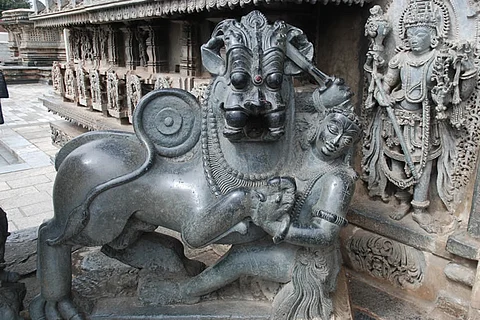

Silvery fronds of sugarcane, banana plantations and coconut groves, carpets of yellow sunflowers and vast vistas of orange marigolds loomed into view heralding us into Hassan district. I was on a heritage sojourn to marvel at the sculptural extravagance of the Hoysala temple of Chennakeshava in Belur along with a motley group of travel agents and writers.
Sheer poetry in stone, the Chennakeshava Temple is an art connoisseur’s delight. The temple, which commemorates the victory of the Hoysalas over the Cholas in the great Battle of Talakad, took 103 years to complete. It is the only Hoysala temple still in active worship. Located on the banks of River Yagachi, Belur was the capital of a mighty empire ruled by the Yadav kings.

The tall stone pillar in the temple courtyard
Narrating an interesting tale of how the Hoysala dynasty got its name, our guide Aslam Sharief said ‘Hoy Sala’, meaning strike Sala, were the words called out to Sala, the legendary head of the dynasty, when he was involved in armed combat with a tiger. Sala immortalised himself and the tiger by single-handedly killing the beast, and this tale of heroism became the royal emblem of the Hoysala dynasty. You can see it in the carvings at the entrance of most of the temples built by the Hoysalas.
We entered the massive walled courtyard where the star-shaped main temple stands surrounded by smaller shrines and columned mandapas and hallways. The first thing that caught my attention was the towering ornamental gopuram of the temple. Admiration for the architecture starts right from the winged figure of Garuda, Vishnu’s carrier, at the entrance, facing the temple, palms touching in homage. Also incredible is a tall stone pillar in the temple courtyard, with nothing to balance it but its own centre of gravity. As we approached the temple, the friezes of elephants, each different from the other, marching in a single line, mythological figures, military scenes, dancers and musicians, and elaborate decorative motifs loomed into view.

The towering gopuram
Every inch of the walls are covered with carvings depicting scenes from the Mahabharata and Ramayana – the 18-day war, pranks that the Pandavas and Kauravas played on each other – all done with microscopic attention to detail. Carvings on the plinth and lower walls, in successive and continuous bands, start at the bottom with depictions of 650 elephants, each one in a different configuration. They seemed to hold the rest of the sculptures on their shoulders. This is followed by garlands and arches with lion heads. The sculptures also depict the lifestyle and other leisure activities of the people of that era.
But it is the angled bracket figures depicting 38 madanikas or celestial nymphs outside and four inside found exclusively at Belur that are the most fascinating of all the sculptural decorations. The beautiful and expressive nymphs are depicted singing, dancing, beautifying themselves and executing their daily chores. They are adorned with a wealth of detail in their make-up, jewellery and coiffure. The sculpted beauties flaunt 600 different styles. All around the temple, the three-dimensional figures of deities and dancing girls that adorn the outer pillars are chiselled with astounding finesse and realism. There is the goddess, for instance, who is squeezing water out of her hair and you can see the drops collected on hair-ends and dripping from it.

Exquisite carving of a dancer beating a drum
We caught another dancer in the act of beating his drum; yet another beautifully carved figure holds a bowl of fruit on which a fly has landed. A large lizard lurks just a few inches away, its mouth open in readiness to lap the hapless insect. One annoyed lady is shooing away a monkey who is pulling at her sari, while another brushes away a scorpion from her garment. Another sculpture outside the temple depicts a lady with a 180 degree turn of her body, anatomically impossible. But it is the stunning sculpture of the Darpanasundari (lady with a mirror), the epitome of beauty, grace and charm, which steals the show.

Darpanasundari, lady with a mirror
More interesting sculptures awaited us in the dark interior of the temple. We saw distinctive pillars, lathe-turned, embellished with a profusion of carvings. Our guide pointed to the walls and ceiling, revealing 48 perfectly polished, carved pillars with their elegant geometric designs and life-size statues of Vishnu and Lakshmi and other deities that seem to step forth from the stone. The embellishments on the ceiling are wondrous; in places the carvings are floral or serpentine.

Beautiful carvings on the lower walls
The Narasimha Pillar once revolved on its ball-bearing foundation. One pillar of a dancing lady features bangles which can be moved up and down on her arms, and another has a head dress with a tiny, movable ring. The smooth circular platform in front of the shrine has a sculpture of Shanthala Devi, King Vishnuvardhana’s queen. Equally impressive are the temples of Chennigaraya, Viranarayana, Sridevi and Bhoodevi, all in the same complex.
We spent hours gasping at the stunning beauty of the whole structure. It took at least two hours to do a round of the temple exteriors and interiors. We completely lost all track of time. There’s so much to see in just one temple and one feels tempted to linger for a few days more.
All photographs by Susheela Nair.
Susheela Nair is an independent food, travel and lifestyle writer, and photographer based in Bangalore. She has contributed content, articles and images on food, travel, lifestyle, photography, environment and ecotourism to several reputed national publications. Her writings constitute a wide spectrum, including guide books, brochures and coffee table books.